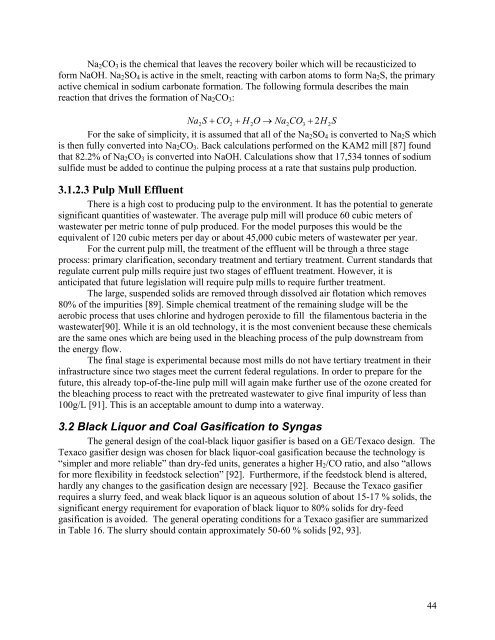Novel Design of an Integrated Pulp Mill Biorefinery for the ...
Novel Design of an Integrated Pulp Mill Biorefinery for the ...
Novel Design of an Integrated Pulp Mill Biorefinery for the ...
You also want an ePaper? Increase the reach of your titles
YUMPU automatically turns print PDFs into web optimized ePapers that Google loves.
Na2CO3 is <strong>the</strong> chemical that leaves <strong>the</strong> recovery boiler which will be recausticized to<br />
<strong>for</strong>m NaOH. Na2SO4 is active in <strong>the</strong> smelt, reacting with carbon atoms to <strong>for</strong>m Na2S, <strong>the</strong> primary<br />
active chemical in sodium carbonate <strong>for</strong>mation. The following <strong>for</strong>mula describes <strong>the</strong> main<br />
reaction that drives <strong>the</strong> <strong>for</strong>mation <strong>of</strong> Na2CO3:<br />
Na2S + CO2<br />
+ H 2O<br />
→ Na2CO3<br />
+ 2H<br />
2S<br />
For <strong>the</strong> sake <strong>of</strong> simplicity, it is assumed that all <strong>of</strong> <strong>the</strong> Na2SO4 is converted to Na2S which<br />
is <strong>the</strong>n fully converted into Na2CO3. Back calculations per<strong>for</strong>med on <strong>the</strong> KAM2 mill [87] found<br />
that 82.2% <strong>of</strong> Na2CO3 is converted into NaOH. Calculations show that 17,534 tonnes <strong>of</strong> sodium<br />
sulfide must be added to continue <strong>the</strong> pulping process at a rate that sustains pulp production.<br />
3.1.2.3 <strong>Pulp</strong> Mull Effluent<br />
There is a high cost to producing pulp to <strong>the</strong> environment. It has <strong>the</strong> potential to generate<br />
signific<strong>an</strong>t qu<strong>an</strong>tities <strong>of</strong> wastewater. The average pulp mill will produce 60 cubic meters <strong>of</strong><br />
wastewater per metric tonne <strong>of</strong> pulp produced. For <strong>the</strong> model purposes this would be <strong>the</strong><br />
equivalent <strong>of</strong> 120 cubic meters per day or about 45,000 cubic meters <strong>of</strong> wastewater per year.<br />
For <strong>the</strong> current pulp mill, <strong>the</strong> treatment <strong>of</strong> <strong>the</strong> effluent will be through a three stage<br />
process: primary clarification, secondary treatment <strong>an</strong>d tertiary treatment. Current st<strong>an</strong>dards that<br />
regulate current pulp mills require just two stages <strong>of</strong> effluent treatment. However, it is<br />
<strong>an</strong>ticipated that future legislation will require pulp mills to require fur<strong>the</strong>r treatment.<br />
The large, suspended solids are removed through dissolved air flotation which removes<br />
80% <strong>of</strong> <strong>the</strong> impurities [89]. Simple chemical treatment <strong>of</strong> <strong>the</strong> remaining sludge will be <strong>the</strong><br />
aerobic process that uses chlorine <strong>an</strong>d hydrogen peroxide to fill <strong>the</strong> filamentous bacteria in <strong>the</strong><br />
wastewater[90]. While it is <strong>an</strong> old technology, it is <strong>the</strong> most convenient because <strong>the</strong>se chemicals<br />
are <strong>the</strong> same ones which are being used in <strong>the</strong> bleaching process <strong>of</strong> <strong>the</strong> pulp downstream from<br />
<strong>the</strong> energy flow.<br />
The final stage is experimental because most mills do not have tertiary treatment in <strong>the</strong>ir<br />
infrastructure since two stages meet <strong>the</strong> current federal regulations. In order to prepare <strong>for</strong> <strong>the</strong><br />
future, this already top-<strong>of</strong>-<strong>the</strong>-line pulp mill will again make fur<strong>the</strong>r use <strong>of</strong> <strong>the</strong> ozone created <strong>for</strong><br />
<strong>the</strong> bleaching process to react with <strong>the</strong> pretreated wastewater to give final impurity <strong>of</strong> less th<strong>an</strong><br />
100g/L [91]. This is <strong>an</strong> acceptable amount to dump into a waterway.<br />
3.2 Black Liquor <strong>an</strong>d Coal Gasification to Syngas<br />
The general design <strong>of</strong> <strong>the</strong> coal-black liquor gasifier is based on a GE/Texaco design. The<br />
Texaco gasifier design was chosen <strong>for</strong> black liquor-coal gasification because <strong>the</strong> technology is<br />
“simpler <strong>an</strong>d more reliable” th<strong>an</strong> dry-fed units, generates a higher H2/CO ratio, <strong>an</strong>d also “allows<br />
<strong>for</strong> more flexibility in feedstock selection” [92]. Fur<strong>the</strong>rmore, if <strong>the</strong> feedstock blend is altered,<br />
hardly <strong>an</strong>y ch<strong>an</strong>ges to <strong>the</strong> gasification design are necessary [92]. Because <strong>the</strong> Texaco gasifier<br />
requires a slurry feed, <strong>an</strong>d weak black liquor is <strong>an</strong> aqueous solution <strong>of</strong> about 15-17 % solids, <strong>the</strong><br />
signific<strong>an</strong>t energy requirement <strong>for</strong> evaporation <strong>of</strong> black liquor to 80% solids <strong>for</strong> dry-feed<br />
gasification is avoided. The general operating conditions <strong>for</strong> a Texaco gasifier are summarized<br />
in Table 16. The slurry should contain approximately 50-60 % solids [92, 93].<br />
44

















